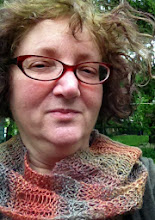
The top of Crusoe has a rolled edge and I already had a ribbed top, but I kept right on. I don't care for rolled tops on socks. As I got going I saw that things were looking very good. The colors were coming through in the design. This is good news as I had already tried 84 different things with that yarn. At about 2 inches of pattern I saw that the colors were forming a secondary pattern of nearly horizontal stripes around the sock. I had really wanted a true variegation with no detectable color patterning, but I'm not unhappy with it at all.

Apparently unable to leave well enough alone, I began to wonder how it would have looked in stockinette. Would it swirl or zig-zag or make splotches and puddles? So just for curiosity's sake please examine the pictures. Each is a different view of the same sock. On the right of each is the ribbed cuff section. The middle has the slipped stitches from Crusoe and the left end, next to the needles is stockinete. You can see that there is pooling on the cuff and in the stockinette section, while the center section of slipped stitches is making light and dark stripes that swirl slightly diagonally. You can see from the pooling in the stockinette and ribbed sections that these socks would be different depending where the dark and light sections ended up in the finished sock. The slipstitch patterning saves the sock. I'd use it again.

Apparently unable to leave well enough alone, I began to wonder how it would have looked in stockinette. Would it swirl or zig-zag or make splotches and puddles? So just for curiosity's sake please examine the pictures. Each is a different view of the same sock. On the right of each is the ribbed cuff section. The middle has the slipped stitches from Crusoe and the left end, next to the needles is stockinete. You can see that there is pooling on the cuff and in the stockinette section, while the center section of slipped stitches is making light and dark stripes that swirl slightly diagonally. You can see from the pooling in the stockinette and ribbed sections that these socks would be different depending where the dark and light sections ended up in the finished sock. The slipstitch patterning saves the sock. I'd use it again.

 In other news, here is a picture of the red potholders. They are made of 3 scrap yarns, one cotton worsted, one cashmere dk, and one wool sock weight, held together and knit on size 5 needles. Garter stitch was used throughout. One was knit horizontally, while the other was knit vertically to make the ribbing go in different directions. Yes, I'm up there with the big designers. While they were a work in progress, they were literally a pain in the arse as they and their 3 balls of yarn kept invading where I was trying to sit to knit other things. Insistent is what they were. Uses: 1; Number of near burns: 1; Having the couch back? Priceless.
In other news, here is a picture of the red potholders. They are made of 3 scrap yarns, one cotton worsted, one cashmere dk, and one wool sock weight, held together and knit on size 5 needles. Garter stitch was used throughout. One was knit horizontally, while the other was knit vertically to make the ribbing go in different directions. Yes, I'm up there with the big designers. While they were a work in progress, they were literally a pain in the arse as they and their 3 balls of yarn kept invading where I was trying to sit to knit other things. Insistent is what they were. Uses: 1; Number of near burns: 1; Having the couch back? Priceless.
4 comments:
How interesting! I'll be putting up pictures of my Conwy socks in progress. The cable pattern doesn't keep them from pooling, but that is not surprising, as they are very little cables with only 2 stitches trading places. It's too close to stockinette to make a difference.
Now, are you going to remember on your second sock how many rows of slip stitch you have and how many rows of stockinette? I like that yarn. I also don't mind pooling. Not that I'm hinting or anything....
Oh--I'ma gonna rip 'er and do all slipping. First I'm going try a coupla other stitches in the interest of fun.
I like your attention to detail! The Supermerino makes awesome socks, very squooshy and luxurious.
I cast on for your socks yesterday. I'm so excited for you to see the finished product!
Post a Comment